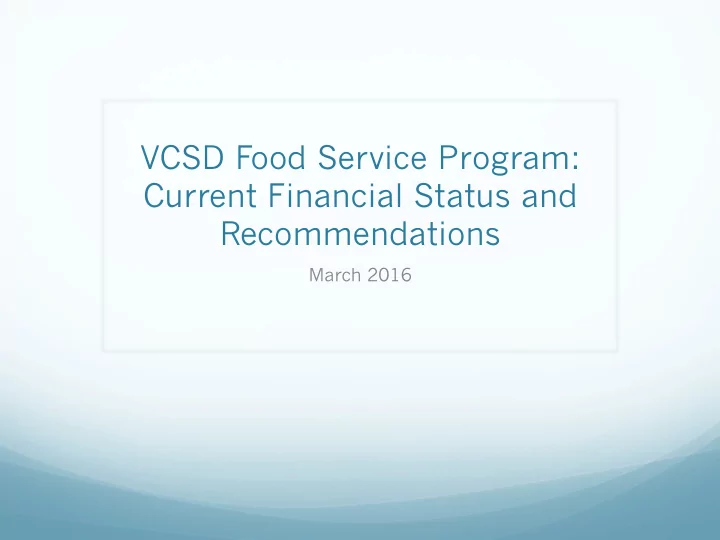

VCSD Food Service Program: Current Financial Status and Recommendations March 2016
Goals of the Food Service Program We provide a food service program to: Serve nutritious meals to our students Help our students learn better in school Provide meals (at reduced cost or free to those who qualify) to children whose families have limited financial means
Losses in Food Service Our food service program, like most school food service programs, has consistently lost money The primary reason most school food service programs lose money is a change in accounting which requires health benefits of food service employees to be included in the lunch fund Our district has had to make 2 large payments from the general fund in the past to make up for accumulated losses ($95,000 in 2008 and $100,000 in 2015) We have budgeted a $20,000 transfer from the general fund to cover this year’s projected food service losses
Current Losses in Food Service At the halfway point of the school year, the current status of the lunch fund is: Operating losses year to date = -$10,400 (equal to last year YTD losses) Despite the one time $100,000 payment approved by voters last May, the lunch fund had a carryover loss of $8,800 to start this school year The current lunch fund balance is -$19,200
Trends in the Food Service Program At the halfway point of the school year: Revenues YTD are up $14,000 Expenses YTD are up $14,000 Breakfast sales are up, lunch sales are down Ave. daily lunch sales are 451 lunches - down 26 Ave. daily breakfast sales are 18 - up 2 (60% eating breakfast a the MS/HS are free or reduced status – no breakfast is currently served at the ES)
Recycling To recycle all possible items other than lunch trays has no impact on the school lunch fund Recycling of those items is now being done through our existing waste vendor Using recyclable lunch trays involves an increased net cost (recyclable minus Styrofoam) of $3,600 per year for the trays, and $300 per year to recycle the trays We would still purchase some Styrofoam trays for use when we are short of staff – total cost currently of Styrofoam trays is $1,150 per year – this cost would be considerably less if we use another type of tray
Washing Trays at the MS/HS We were able to begin using reusable trays at the ES this year – a staff member was shifted to the ES so there is a person to operate the tray washer there For the MS/HS to wash reusable trays, we would have to purchase a tray washing machine, as well as reusable trays, silverware, and bowls We would also need to hire an additional staff member to handle washing trays: A 2.5 hour employee would cost $5,174 per year (no benefits) A 4 hour employee would cost $31,200 per year (benefits) The cost of washing trays at the MS/HS is $11,200 for the one-time purchases and $5,174 for the on-going staff increase (assuming a 2.5 hour employee)
Analysis and Recommendations Recycling of all possible items should begin as soon as we have the containers from our current waste vendor. Any change in tray use should seek to minimize total costs to the food service budget, and enhance efficiency. Both tray options have close to the same on-going costs. The washable trays are the more efficient option. A difference in the two options is the one time cost for the tray washer, reusable trays, etc. We do not have the funds in the appropriate budget code to purchase the tray washer (cost =$8,500) this year. We are restricted with regard to transfers into equipment codes. The tray washer could be purchased next year if the expense is included in the operations equipment budget. Lunch and breakfast prices should be raised 10 to 15 cents for next school year to reduce the lunch fund deficit. We should consider implementing a bagged breakfast program for the ES for next year. We can work out a plan and determine the cost (this would be eligible for Federal reimbursement). The lack of an ES breakfast program is a significant gap in our food service program – we have 46 free or reduced eligible students in the ES (9% of total students).
Recommend
More recommend